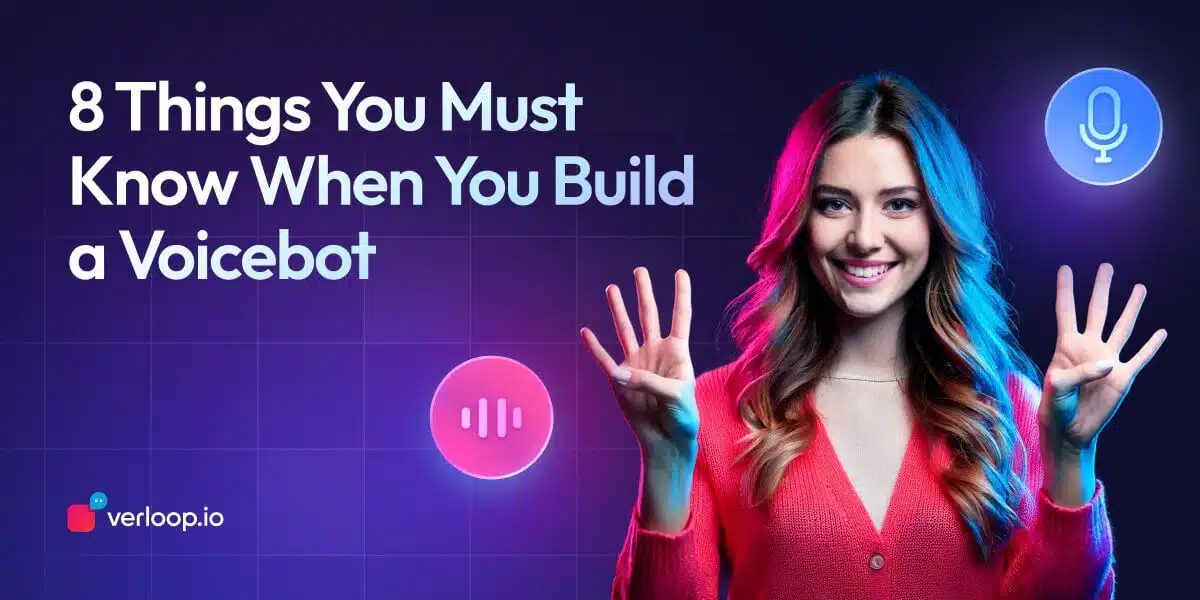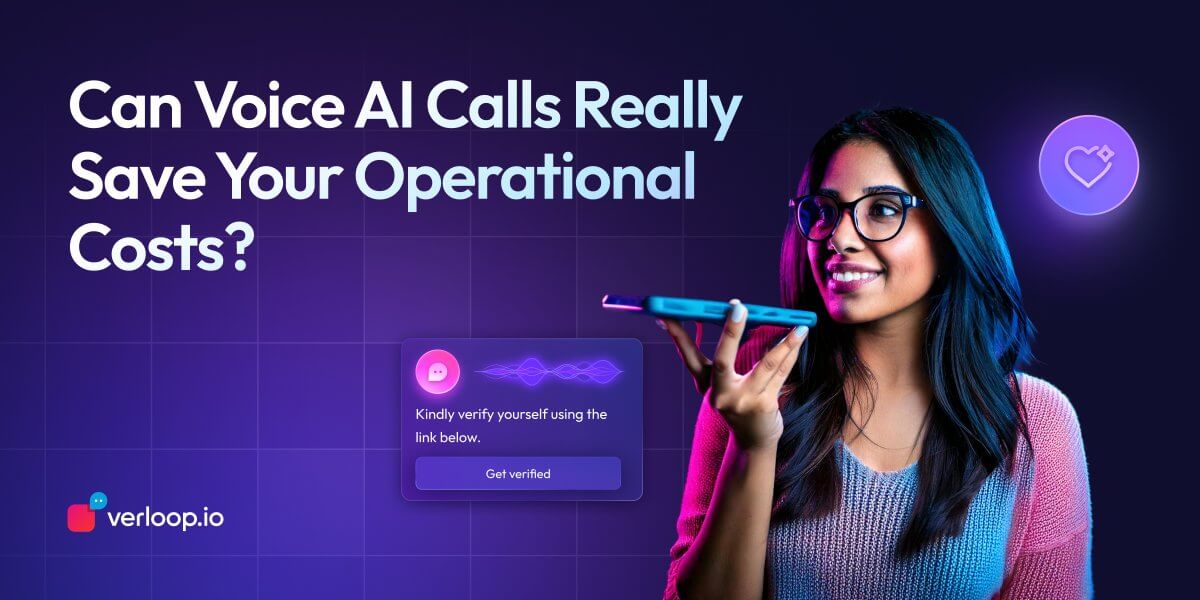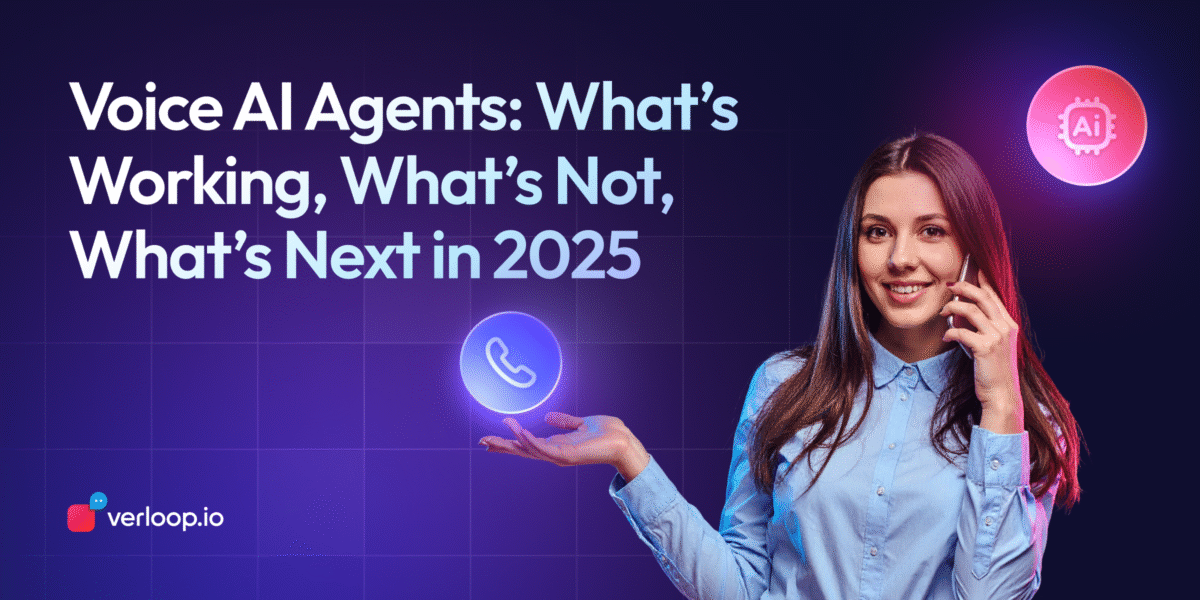
8 Things You Must Know When You Build a Voicebot
- March 3rd, 2025 / 5 Mins read
-
 Aarti Nair
Aarti Nair
What does it take to build a voicebot that exceeds expectations? We lay down the 8 important things you must remember when building a voicebot for your business. Read more!
The world has changed a lot since artificial intelligence was first conceptualised by John McCarthy in 1956. AI started as a simple idea of mimicking human thought processes. Over the years, it evolved from rule-based systems to complex neural networks.
Today, we find ourselves in the Gen AI era. Gen AI agents are not only capable of understanding context but also hold conversations that feel natural. They have changed how businesses interact with customers, enabling smooth conversation automation that was once only a dream. This progress has made it possible for systems like gen AI-powered voicebots to handle everyday queries with ease, clarity and empathy.
While text-based AI chatbots have been around in customer service for a while, voicebots and voice AI is 3.7x faster than typing and is rising in popularity. Both voice and chat AI can bring your CX and CSAT up, but voicebots and chatbots have a few key differences.
And for those, who have decided to build a voicebot, we’ve put together a list of the best practices so you can get the best for your brand.

What is a voicebot?
A voicebot is an AI-powered conversational solution that interacts with users in natural language. It uses natural language processing (NLP), automatic speech recognition (ASR), and speech-to-text (STT) to respond with relevance and accuracy.
While these 3 make up the architectural foundation of the technology, as a builder of one for your own business, you must take several factors into account.
A voicebot is a software application that uses voice recognition and natural language processing to understand and respond to your spoken words. It acts much like a digital assistant, handling both voice AI inbound and voice AI outbound tasks. For example, when you speak to the bot to check the weather, it listens, processes your request, and replies with the current conditions. Similarly, a voicebot can also make outbound calls, such as reminding you of an appointment or confirming a booking, making it a handy tool for everyday tasks.
Types of voicebots
Voicebots are increasingly popular, with recent studies suggesting that over 60% of organisations now utilise some form of voice AI in their customer engagement strategies. This rise in adoption is partly driven by the evolution of Gen AI voice solutions, which enable more natural, context-aware conversations with customers. Modern voicebots are designed to handle both inbound voice AI—receiving and processing customer queries—and outbound voice AI—initiating calls for notifications, reminders, or follow-ups.
Learn more about Voice AI solutions and how you can implement them.
-
Basic Command Bots
These bots focus on executing direct commands with minimal dialogue. They are built for straightforward tasks, where the conversation is limited to clear, concise requests.
Imagine a user asking, “What time is my next appointment?” The bot quickly retrieves and provides the scheduled time. In another scenario, a basic command bot might answer, “Play some music,” directly linking to a streaming service. These bots are often used in environments where speed and efficiency are essential.
2. Conversational Agents
Conversational agents are designed to mimic natural human conversation. They use advanced natural language processing to understand context and maintain a back-and-forth dialogue. These agents support both inbound voice AI, where they handle customer queries in real time, and outbound voice AI, such as making follow-up calls based on previous interactions.
A customer might call to enquire about their recent order. The voicebot engages in a dialogue, asking follow-up questions to confirm details, and then provides real-time updates on the order’s status. In an outbound scenario, the bot might call to confirm a delivery time, ensuring the customer is informed and prepared.
3. Task-Specific Bots
Task-specific bots are developed to address particular business functions like customer support or appointment scheduling. They are programmed to follow specific protocols and workflows to resolve user issues or provide precise information.
Consider a bank using a task-specific voicebot to assist with account inquiries. When a customer calls about recent transactions, the bot not only retrieves transaction details but may also initiate an outbound voice AI call to verify any suspicious activity. This ensures both proactive and reactive customer engagement, enhancing security and trust.
4. Hybrid Bots
Hybrid bots combine the strengths of both voice and text interaction, offering flexibility to users. They can switch between spoken dialogue and typed responses based on the context or user preference. These systems are particularly effective in environments where continuous engagement is needed.
A customer might start interacting with a hybrid bot via a phone call (inbound voice AI) to troubleshoot a product issue. Later, if the situation requires detailed instructions, the bot might send a follow-up text or email. Similarly, the bot can initiate outbound voice AI calls to update the customer on the status of their service request.
5. Gen AI Voice Solutions for Customer Engagement
Gen AI voice solutions have redefined customer engagement by creating more intuitive and responsive systems. They not only process voice commands but also analyse conversational context, making it easier to provide personalised responses. For instance, a retail business might use a Gen AI voice solution to manage both inbound queries—helping customers find products—and outbound communications—sending order confirmations or promotional offers. This seamless integration of inbound and outbound voice AI enhances customer experience and drives efficiency.
In summary, whether you are using a basic command bot for simple tasks, a conversational agent for dynamic dialogues, a task-specific bot for focused applications, or a hybrid solution for flexible interactions, understanding the strengths and appropriate use cases of each type will help you build a voicebot that truly supports your customer engagement strategy.
Know everything about voice AI in our all-in-one comprehensive guide!
8 Things You Must Know When You Build a Voicebot
Building a voicebot is a careful process that balances technical precision with a human touch. Whether your goal is to enhance customer service or streamline routine tasks, keeping these eight steps in mind will help you create a tool that listens well, learns continuously, and interacts naturally.
1. Take all utterances into account
You need to understand that people tend to be more descriptive when speaking compared to texting. For example, if a customer explains an issue with their billing by saying, “I think there’s a mistake in the amount shown on my bill because I was charged extra last month,” your voicebot should recognise the various ways this intent might be expressed.
Even if the spoken input doesn’t match your predefined intent exactly, you want your voicebot to capture the meaning. Stock as many variations of this utterance as possible to ensure your voice bot understands the concern accurately.
2. Personalise responses
Imagine a customer calling about their recent order. Instead of offering a generic reply, you should design your voicebot to use the customer’s name and reference previous interactions. For example, “Hi Sarah, I see you ordered a pair of shoes last week. How can I help you with your order today?” This tailored approach makes the conversation feel more personal and engaging.
3. Add personality
Your voicebot shouldn’t just sound robotic; it should have a friendly and relatable tone. Think of it as chatting with a helpful assistant. For example, when a customer asks for store hours, instead of a plain “Our store is open from 9 am to 5 pm,” your voicebot might say, “Hey there! We’re open from 9 am to 5 pm, ready to help you find that perfect gift!” This small touch can make interactions more memorable.
Voicebots are capable of having intuitive and natural conversations that are so real that users feel they’re talking to a real person. When talking to a person, you associate a personality with them. One of the best voice AI practices is to give your bot a personality.
You can train and build a voicebot to respond to queries in a way that reflects your brand’s tone of voice.
Give your voicebot a friendly personality. A voice AI with personality is interactive (keeps your user gripped) and makes your customers associate your brand with consistency in delivering responses.
For example, build a voicebot that starts the conversation with “Hi [user’s name]! My name is [bot name] and I hope you are doing great this evening. I’d love to help you if you are stuck anywhere!”
4. Handle errors with multiple iterations
Errors are inevitable. When your voicebot fails to understand a query, instead of a frustrating “I didn’t get that,” try something like, “I’m sorry, I didn’t quite catch that. Could you please rephrase your question?” For example, if a customer says something unexpected, your bot should politely ask for clarification rather than abruptly ending the conversation.
Just like anyone speaking naturally would enable your voicebot to respond in different ways.
“I am not sure I understand. Could you please repeat that for me?”
“Uh oh! I don’t think I understand what you mean. Please explain your concern.”
“Sorry! I didn’t catch that. Could you please try explaining it again?”
And if your voicebot is still struggling to understand the user, ensure a smooth hand-off to a live agent to minimise inconvenience for the user.
5. Build a voicebot to evolve and learn
You should design your voicebot to continuously learn from each conversation. For instance, if a particular query keeps causing confusion, your system should update its understanding over time. Imagine a scenario where users frequently ask about a new feature; your bot should adapt its responses based on these interactions to become more accurate and helpful.
Pro Tip: Learning is as good as its practical application. Ensure your voice AI is thoroughly tested after iterations to avoid any preventable mishaps during support conversations. Continuous learning keeps your bot in the best shape.
6. Make your voicebot journeys easily navigable
When customers interact with your voicebot, they should find it easy to navigate through the options. For example, if a user wants to check their account balance, the bot should provide clear directions: “To check your balance, say ‘account balance’ or press 1.” This clarity prevents frustration and makes the experience smoother.
Psst…We have talked about why short and direct AI conversation flows are essential for an elevated user experience in our perfect recipe for a robust conversational AI strategy!
7. Choose the right solution provider
You need to work with a solution provider that not only offers robust technology but also supports you through the entire development process. Imagine having a partner who guides you from the initial setup to continuous optimisation, ensuring your voicebot remains effective and up-to-date.
8. Implement speech normalisation
People speak with different accents, speeds, and pronunciations. For instance, a customer from Scotland might say “I’m nae happy with my bill,” while another from London might say, “I’m not happy with my bill.” Your voicebot should normalise these variations so it understands both in the same way. Implementing speech normalisation techniques helps your bot accurately interpret diverse speech patterns, enhancing the overall user experience.
Each of these steps is crucial for building a voicebot that not only understands your customers but also delivers a seamless and engaging interaction every time.
Once your voice AI is in full swing, you’d love to know: How to Measure the Success of Your Voice AI Bot?
When all is said and done…
We’re seeing a steady rise in businesses adopting conversational AI over the years. To put that into perspective, the number of voice assistants will outnumber the global population by 2025!
Improving CX is a top priority for brands, and there’s no better way to do it than with a conversational AI. A well-made voice AI can do wonders for your business while keeping your customers as happy as they can be.
The keyword here is well-made.
At Verloop.io, we’re dedicated to helping businesses build robust conversational AI strategies tailored to their needs. Get in touch with us now for a free consultation and demo!







